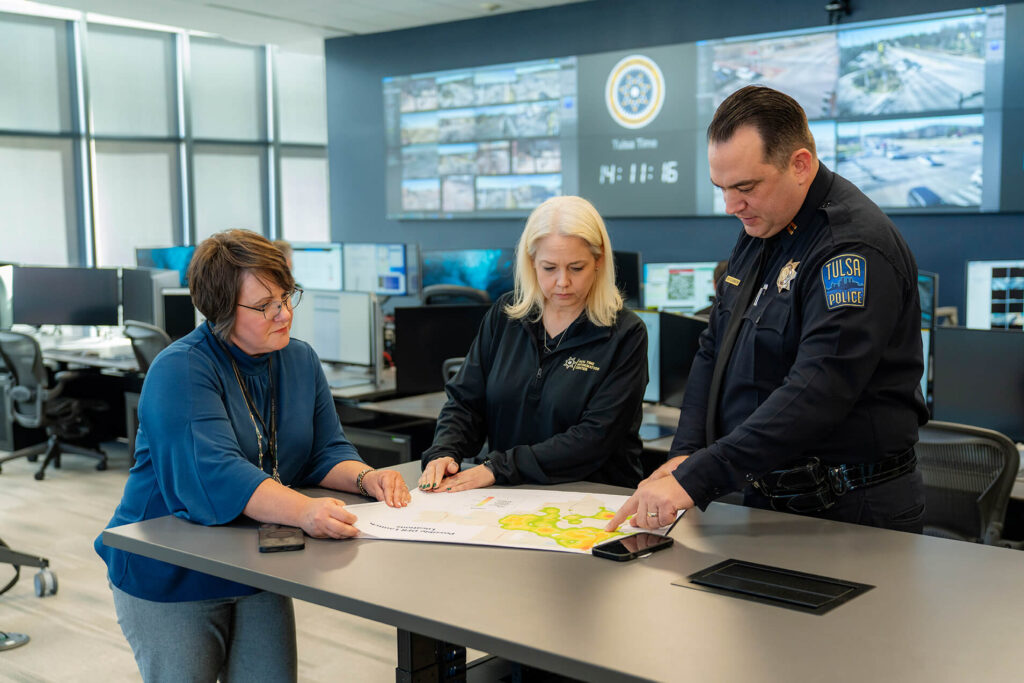Haivision Technology Powers Tulsa PD’s Real-Time Information Center
Home to over 400,000 residents, the city of Tulsa, Oklahoma offers a unique blend of big-city amenities and a strong sense of community. Tulsa boasts a thriving arts scene, with renowned art deco architecture, world-class museums, and a full-time ballet and opera company. However, like many urban centers, Tulsa also faces its share of challenges, making the Tulsa Police Department’s role in maintaining public safety crucial.
Tara Brians
Real-Time Information Center Manager,
Tulsa Police Department

To address public safety challenges, the Tulsa Police Department had decided to create a Real Time Intelligence Center (RTIC), similar to what some public safety organizations refer to as a Real-Time Crime Center (RTCC). As Captain Jacob K. “Moose” Johnston, Real Time Information Center Commander, points out, “As a major city, we have a lot of challenging situations. Whether it’s a known or spontaneous event, we’ve seen across the United States how RTCCs have benefitted cities by bringing all their technology into one location to help them address the challenges that come up. By seeing other agencies be effective with that, we decided that we needed to do something similar here.”
The limitations of traditional response methods became evident during past events. In 2020, Tulsa, like many cities, experienced protests and civil unrest. While the city had first responders, there wasn’t a central hub for collaboration and real-time information sharing. A similar situation arose in 2021 during the centennial anniversary of the 1921 Tulsa Race Massacre. The need to manage large crowds and coordinate security with state and federal agencies, including the Secret Service, for President Biden’s visit underscored the limitations of existing infrastructure.
Tulsa PD observed how RTCCs and RTICs were proving beneficial in other cities, such as the RTCC operated by Cobb County Police Department in Atlanta. However, they recognized the broader potential of such a center, encompassing all aspects of public safety, not just crime. Capt. Johnston elaborates: “We learned along the way that RTCCs seem to be focused on crime but the technology available helps with any kind of public safety issue.”
The Tulsa Police Department’s response to these challenges involved the creation of an RTIC equipped with Haivision video wall technology, designed by Constant Technologies, a leading command and control center solutions provider and integrator. This center serves as a central source of intelligence and situational awareness for the city, providing real-time data, information sharing, and collaborative decision-making for a wide range of public safety needs.
The successful implementation of the RTIC relied heavily on the mission-critical expertise of Constant Technologies to deliver a quality solution. The design of the RTIC reflects its focus on interaction and collaboration. The space is configured to be user-friendly for both RTIC specialists and officers. It features:
The Tulsa Police Department’s investment in the RTIC has yielded significant results across various aspects of public safety. Here’s a closer look at the key benefits:
Enhanced Situational Awareness and Officer Safety: The RTIC provides officers with a critical advantage through real-time data and information sharing. This includes license plate reader (LPR) data, camera feeds (VMS), and records management system (RMS) integration, giving officers a comprehensive picture before arriving at a scene.
“The content that we put on the video wall on a day-to-day basis is for situational awareness. Now, with the video feed accessibility and large video wall visibility, there’s no question of what officers are seeing and what they’re having to address,” Capt. Johnston explains.
Interactive Support for Officers: The RTIC goes beyond information dissemination; it fosters a dynamic two-way communication channel. Specialists actively monitor calls, research details, and provide real-time support to officers in the field. For instance, they can identify a history of domestic violence at a location, allowing officers to be prepared for a potentially volatile situation. As Capt. Johnston highlights, “There’s a very interactive relationship between the RTIC and the officers on patrol.” This collaborative approach ensures a coordinated response and improves officer effectiveness.
Multi-Agency Collaboration: The RTIC isn’t limited to the Tulsa police department. The video wall facilitates real-time collaboration between various public safety agencies. Imagine a major weather event: the RTIC can display a map showing the location of officers, resources, and power outages. This centralized view enables a coordinated response, ensuring resources from other agencies are deployed efficiently to areas in the greatest need.<?p>
Improved Efficiency and Training: The RTIC has streamlined operations and provided new avenues for training. Tara Brians, Real-Time Information Center Manager, points out, “The RTIC has really helped us achieve several of our goals while remaining effective but lean. The video wall can be a source of education, allowing the team to highlight areas of improvement for officers for different scenarios.”<?p>
Community Engagement: The RTIC isn’t just about internal operations; it also plays a role in community engagement. The video wall allows for transparency and fosters a sense of trust between the police department and the public.<?p>
The success of the Tulsa PD’s RTIC extends beyond the technology itself. Building strong partnerships was crucial. Tara Brians acknowledges this, stating, “Building an RTIC and having partners like Constant Technologies and Haivision allows us to respond to the community in a completely different way than we have seen in the past.” Constant Technologies’ expertise in design and system integration ensured a seamless implementation, while Haivision’s technology provided a reliable and interactive platform.<?p>
The Tulsa Police Department’s Real Time Information Center, powered by Haivision technology and Constant Technologies’ expertise, is the model for how real-time data, information sharing, and collaboration can significantly enhance public safety and community engagement.<?p>